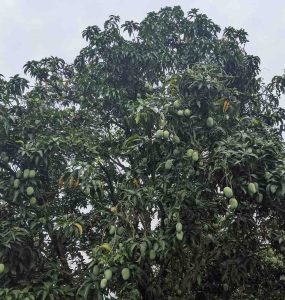Most of us would have heard the famous story from the famous scripture Ramayana, where Lord Ram’s brother, Lakshman was brought to life by consuming a magical Sanjeevani Booti herb. This Himalayan herb had the power to revive even the dead.
We don’t know if this specific herb exists or not, but like Sanjeevani Booti, many plants in our biodiversity possess significant medicinal properties, offering various health benefits.
However, not many of us know that many Trees apart from providing fruits, also have medicinal value through their leaves, flowers, and bark.
Let us look at some of the medicinal trees in nature.
Neem Tree
Scientific name: Azadirachta indica
Neem is one of the best medicinal trees that grows in tropical regions such as India, Africa, and South and Central America.
The tree is large, hardy, and evergreen and has remained an integral part of traditional Indian medicine (Ayurveda). The flowers of the Neem tree are used for many religious rituals and food because of their purifying properties.
The extracts of the Neem Tree have long been used for cosmetic uses, because of their antibacterial and antifungal properties. Neem oil is prominently used by many large brands for making products like toothpaste, cosmetics, soaps, and shampoos.
Neem is also used for nourishing and protecting agricultural crops long before chemicals and insecticides were available.
Willow Tree
Scientific name: Salix
The willow family includes several different species of trees which are typically deciduous, found primarily on moist soils in cold and temperate regions.
The medicinal value of the willow tree especially its leaves and bark has been mentioned in ancient texts from Egypt, China, and Ancient Greece.
The bark of willow trees contains salicin, which is effective in addressing headaches, inflammatory conditions, and back pain.
Peepal Tree
Scientific name: Ficus religiosa
Peepal is a fast-growing deciduous tree native to the Indian subcontinent and Southeast Asian countries.
The word ‘Religiosa’ in the scientific name refers to ‘religion’, as it is considered extremely sacred in Buddhism, Jainism, and Hinduism. In India, there are many temples and religious places where the Peepal tree has found its presence.
The most famous Peepal Tree is the Bodhi Tree, where Buddha attained enlightenment.
Apart from the religious significance Peepal is also a medicinal tree as it is helpful for cough, asthma, diarrhoea, ear pain, migraine, scabies, eye troubles, and gastric problems. The leaves and bark of Peepal Tree are used for various treatments.
Boswellia tree
Scientific name: Boswellia sacra
The Boswellia tree typically grows in the dry, mountainous regions of India, Africa, and the Middle East.
The resin of the Boswellia tree, Frankincense has a history as incense in religious ceremonies, especially by ancient Egyptians. It also treats arthritis, asthma, oral health, and abdominal pain.
Cinnamon Tree
Scientific name: Cinnamomum verum
Cinnamon Tree is a bushy evergreen tree native to Sri Lanka and also found in India, Myanmar, and South America.
The bark of the tree which is sweet and strongly aromatic has been used as a spice for the last hundreds of years. From Biryani to Tea, Cinnamon is extensively used to add flavors to food and make it healthy.
Cinnamon has several nutritional benefits as it helps digestion and has anti-inflammatory, antifungal, and antibacterial properties.

Mango Tree
Scietific Name: Mangifera indica
Mango is one of the most popular tropical fruits known for its sweet and freshening flavors. The evergreen mango tree is found in many countries, but the bulk of mango production happens in the Indian subcontinent and South Asia.
While eating mangoes has so many health benefits, in addition, the leaves and bark of the mango tree are used to treat conditions like skin disorders, fever, and digestive problems.
You can read interesting facts about the Mango Tree here.
Birch Tree
Scientific name: Betula
Birch Trees are thin-leaved deciduous hardwood trees, native to Europe and parts of Asia. The tree is commonly known for its white papery bark.
The leaves, bark, and buds of the Birch tree are used to treat health conditions like joint pain, kidney stones, bladder stones, and urinary tract infections.
Pine Trees
Scientific name: Pinus
Pine Trees are evergreen and coniferous trees that grow abundantly in many parts of the world, especially in the northern hemisphere. There are more than 100 different species of pine trees.
Many cultures use Pine Trees as medicinal trees because various parts of the trees are used to treat different health conditions.
Tea made from pine needles is rich in vitamin C, which supports respiratory health. Pine resin has antiseptic properties and can be applied to cuts and scrapes. Pine bark is an antioxidant that supports a healthy heart and cardiovascular system.
Arjun Tree
Scientific name: Terminalia arjuna
The Arjun Tree is a large deciduous tree seen across the Indian Subcontinent and in Southeast Asia. In India, it is a highly revered medicinal tree and is used for treating different diseases and health issues.
Interestingly, it is the bark of the Arjun tree which is mainly used to treat cardiovascular conditions, including high blood pressure and heart disease.
Wrapping Up
While these medicinal trees offer numerous health benefits and are used for treating diseases, it is crucial to approach their use with caution.
Many medicinal trees can have contraindications, especially for children, pregnant women, or those taking certain medications. Also, it is important to consult a professional regarding their dosage and application.
You might also like to read about the importance of forests.






Add comment